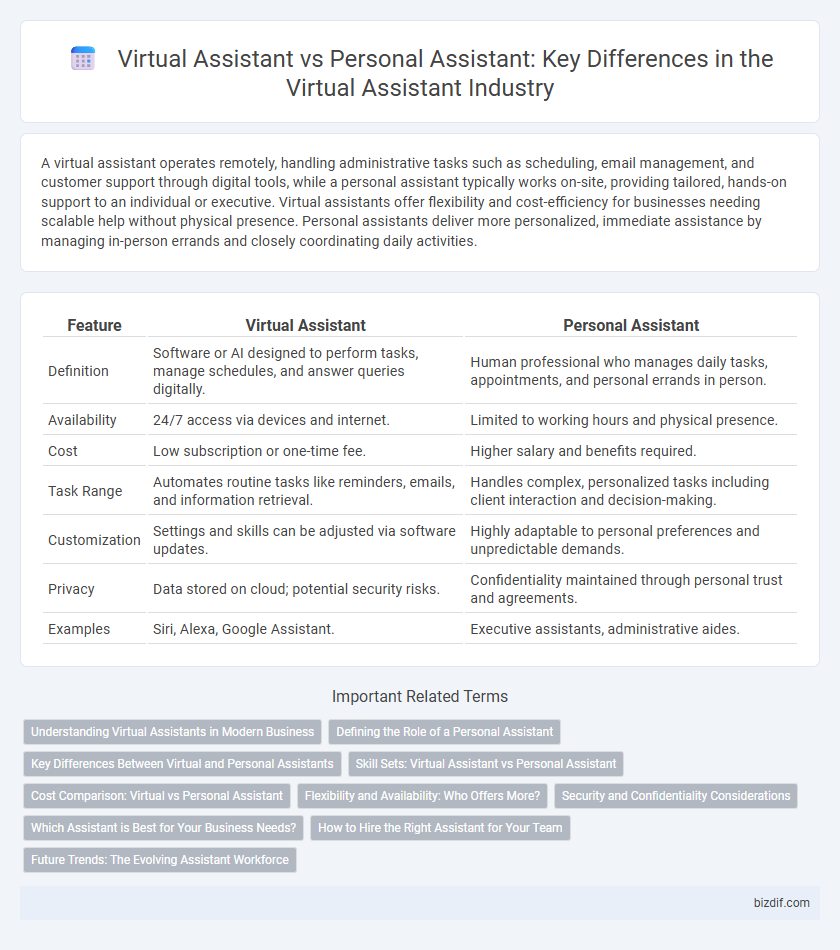A virtual assistant operates remotely, handling administrative tasks such as scheduling, email management, and customer support through digital tools, while a personal assistant typically works on-site, providing tailored, hands-on support to an individual or executive. Virtual assistants offer flexibility and cost-efficiency for businesses needing scalable help without physical presence. Personal assistants deliver more personalized, immediate assistance by managing in-person errands and closely coordinating daily activities.
Table of Comparison
| Feature | Virtual Assistant | Personal Assistant |
|---|---|---|
| Definition | Software or AI designed to perform tasks, manage schedules, and answer queries digitally. | Human professional who manages daily tasks, appointments, and personal errands in person. |
| Availability | 24/7 access via devices and internet. | Limited to working hours and physical presence. |
| Cost | Low subscription or one-time fee. | Higher salary and benefits required. |
| Task Range | Automates routine tasks like reminders, emails, and information retrieval. | Handles complex, personalized tasks including client interaction and decision-making. |
| Customization | Settings and skills can be adjusted via software updates. | Highly adaptable to personal preferences and unpredictable demands. |
| Privacy | Data stored on cloud; potential security risks. | Confidentiality maintained through personal trust and agreements. |
| Examples | Siri, Alexa, Google Assistant. | Executive assistants, administrative aides. |
Understanding Virtual Assistants in Modern Business
Virtual assistants use AI technology to handle tasks like scheduling, customer service, and data management, increasing efficiency and reducing operational costs for modern businesses. Unlike personal assistants, who provide personalized support often involving physical presence, virtual assistants operate remotely through automation and software tools. This distinction enables companies to scale support services and access versatile expertise without geographic constraints.
Defining the Role of a Personal Assistant
A Personal Assistant primarily manages an individual's daily schedule, coordinates appointments, and handles confidential tasks to enhance personal productivity. Unlike virtual assistants who operate remotely providing digital support across various platforms, Personal Assistants often work onsite, offering personalized and immediate assistance. Their role encompasses managing communications, organizing tasks, and anticipating needs to streamline both professional and personal responsibilities.
Key Differences Between Virtual and Personal Assistants
Virtual assistants operate remotely using digital communication tools, while personal assistants typically work on-site providing direct support. Virtual assistants manage tasks such as scheduling, emails, and social media remotely, offering flexibility and cost-efficiency for businesses. Personal assistants often handle more personalized, hands-on duties including in-person errands, event coordination, and confidential tasks requiring physical presence.
Skill Sets: Virtual Assistant vs Personal Assistant
Virtual assistants excel in digital skills like social media management, data entry, and customer support, utilizing tools such as CRM software and cloud-based platforms. Personal assistants often possess strong organizational abilities, handling tasks like scheduling, event planning, and in-person errands, with expertise in communication and time management. The key distinction lies in virtual assistants' proficiency with remote technologies, whereas personal assistants emphasize face-to-face interaction and physical task coordination.
Cost Comparison: Virtual vs Personal Assistant
Virtual assistants typically offer significant cost savings compared to personal assistants due to lower overhead expenses, such as office space and benefits. Hourly rates for virtual assistants generally range from $15 to $50, whereas personal assistants can cost between $30 and $75 per hour depending on location and experience. Businesses often reduce operational costs by choosing virtual assistants for tasks that do not require physical presence, achieving higher efficiency and budget flexibility.
Flexibility and Availability: Who Offers More?
Virtual assistants provide greater flexibility and availability compared to personal assistants, as they operate remotely and can manage tasks around the clock without geographic constraints. Their cloud-based platforms enable seamless integration with multiple devices, ensuring constant accessibility and real-time updates. In contrast, personal assistants typically have fixed schedules and are limited by physical presence, which can restrict responsiveness and availability outside standard working hours.
Security and Confidentiality Considerations
Virtual assistants rely on encrypted cloud-based platforms and advanced AI algorithms to safeguard user data, reducing risks associated with human error prevalent in personal assistants. Personal assistants handle sensitive information directly, which may increase exposure to confidentiality breaches due to lack of standardized security protocols. Implementing strict access controls and continuous monitoring is critical for both virtual and personal assistants to ensure robust security and protect user privacy.
Which Assistant is Best for Your Business Needs?
Virtual assistants offer scalable, cost-effective support with expertise in digital tasks such as social media management and data entry, ideal for businesses seeking flexible remote assistance. Personal assistants provide dedicated, in-person support tailored to executive-level needs, managing schedules, communications, and confidential tasks. Choosing the best assistant depends on the size, budget, and specific operational requirements of your business.
How to Hire the Right Assistant for Your Team
Hiring the right assistant for your team requires understanding the differences between a virtual assistant and a personal assistant, including the scope of tasks, working environment, and communication methods. Evaluate candidates based on their technical skills, availability, and ability to adapt to remote collaboration tools versus hands-on, in-person support. Prioritize clarity in job expectations and assess the candidate's experience with relevant software or administrative tasks to ensure alignment with your team's operational needs.
Future Trends: The Evolving Assistant Workforce
Virtual assistants are leveraging AI advancements to automate routine tasks, enabling businesses to scale support efficiently, while personal assistants continue to emphasize personalized, high-touch service for executive needs. Emerging trends indicate a hybrid workforce where virtual assistants integrate machine learning and natural language processing to handle complex queries, complementing the nuanced judgment of personal assistants. The evolution of the assistant workforce highlights increased collaboration between human and AI roles, driving productivity and shifting job functions towards strategic decision-making and creativity.
Virtual Assistant vs Personal Assistant Infographic

 bizdif.com
bizdif.com